MAGAZINE
The Guitar in Mexico Abel García Fructuoso Zalapa Daniel Caro Carlos Piña David Rubio


Bruno and Catherine Marlat have amassed, over many years, a noteworthy collection of documents on French luthier, René Lacote. Their work has now culminated in a beautiful book, the first to trace this luthier’s life and the history of his fruitful collaborative work. It explains how his guitar-making evolved over time and showcases a selection of his instruments.

© OrfeoMagazine
Founder and Publisher:
Director: Hervé Ollitraut-Bernard
translation: Maria Smith-Parmegiani
assistant: Clémentine Jouffroy
French-English
orfeo@orfeomagazine.fr
Meegan Davis
Thirty-five thousand inhabitants, four hundred luthiers and fifteen factories producing fifty thousand guitars each year!
I had been toying with the idea of visiting this small city in Mexico for years. Now, having made trips to Cremona in Italy, to Markneukirchen in Germany and to Granada in Spain, I realised that I would be remiss not to give this incredible guitar hub its very own Orfeo edition.
I hope that through these pages you will understand the challenges encountered by Paracho’s luthiers and that you will come away, as I did, full of admiration for their skill with knife and plane.
As usual, so few interviews cannot do justice to the many good luthiers in Paracho. In particular, I regret not having been able to meet up with Salvador Castillo, who was experiencing health issues at the time of my visit, nor see his excellent guitars.
Enjoy.
Alberto MartinezThe pre-Columbian city of Paracho is situated at an altitude of 2,200 metres in the Mexican state of Michoacán, 400 kilometres from the country’s capital. It has a cool temperate climate, with very high


annual precipitation: around 1,100 mm.
To survive in this area with low fertility, yet endowed with abundant pines and other woodland species, it was only natural for the city’s inhabitants to make the most of the main resource at their disposal: wood.
At the time of the Spanish conquest, evangelisation of the indigenous peo ple was spearheaded by Fray Juan de San Miguel, and subsequently by Bishop Vasco de Quiroga, who en couraged apprenticeship to foster lo cal skills development, thus turning Paracho into a manufacturing hub for all kinds of stringed instruments, furni ture, handcrafted objects and embroidery.
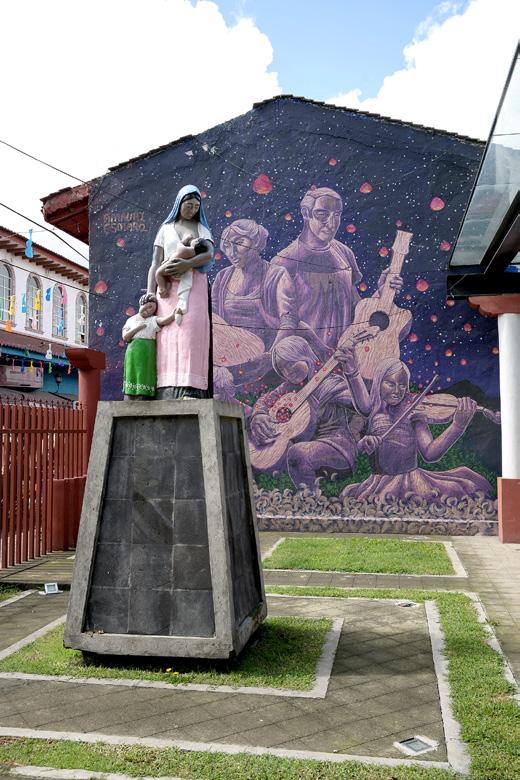
Until the Spanish brought with them the guitar, the lute and other stringed instruments, such items were unknown in the Americas. It was therefore during this era that the indigenous people would have had their first glimpse of such instruments and their earliest opportunity to learn how to craft them.

The earliest guitars built in Paracho were made using locally-grown wood, but as trade, communica tions and transport developed, it became possible to source timbers from other regions with better acous tic and aesthetic qualities. This led to the growth of local businesses specialised in supplying wood for lutherie, not only varieties sourced in Mexico, but also imported from around the world, as is currently the case for the manufacture of highend classical guitars.
There are two distinct phases in the history of the guitar in Para
cho, the first of which covers the period prior to the 1930s, when the stringed instruments being built here, such as the “guitarra séptima” (a seven-course guitar), differed from the six-stringed guitar or Spanish guitar. In this first pe riod, guitar-making was significantly more rustic than it is today.
As of 1940, the construction of sixstringed guitars became the norm, with the adoption of new techniques, tools, materials, woods and models. This period coincided with the arrival of electricity and electric machinery: saws, drills, etc. The advent of new channels of communication further boosted trade, creating a broader market and the imposition of the Span ish guitar.
There are an estimated four hundred luthiers working in and around Paracho today, some of whom have more than 50 years’ expe rience in artisanal guitar lutherie, as well as more than a dozen facto ries, offering a vast range of models, grades and price points. This tradi tion of stringed instrument manufac ture is passed on from generation to generation, chiefly through handson learning.
Monument dedicated to the city’s luthiers.

Shop selling supplies and accessories.
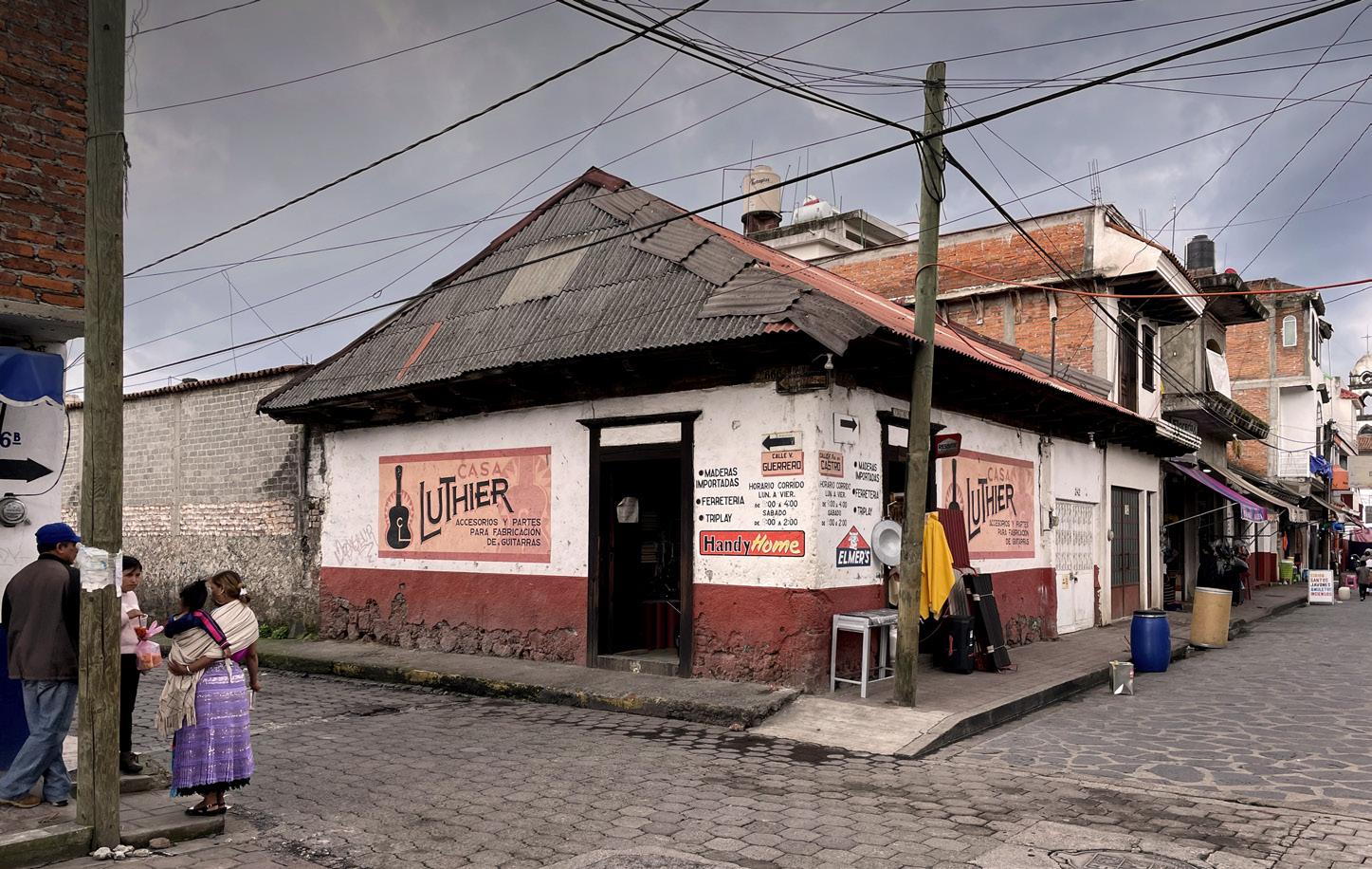
Two of the painted panels in the Cocucho church.
There have also been visits and courses given by eminent luthiers, which helped improve gui tar-makers’ technique and enhance their instru ments’ quality.
Today Paracho boasts a handful of luthiers mak ing very high-quality instruments, and more and more luthiers from Paracho are travelling abroad – to the United States and to Spain, for example –in order to perfect their craft.
Among the instruments that preceded the sixstringed Spanish guitar, the Mexican guitar “gui tarra séptima” has pride of place. We cannot say with any certainty today when or how it arrived in the country. It was in use in Mexico from the late eighteenth century through to the mid-twen tieth century, but its true golden age was in the nineteenth century, starring not only in popular bands and “Mariachi” groups, but also in clas sical music. What is clear, however, is that during Mexico’s
“classicist” phase (1770-1840), the 70-year peri od spanning the end of colonisation and the early days of independence, the seven-course guitar was one of the instruments of choice, along with piano and vocals.
A late seventeenth-century document mentions that in Paracho there are “two hundred and four taxpaying Indians who build vihuelas, violins, chairs, stools and other household furniture”. Some twenty kilometres from Paracho, in the town of Cocucho, there is a church in which the entranceway ceiling is decorated with painted panels, likely from the eighteenth century, de picting angels playing on different musical in struments. Two of these panels are of particular interest to us: one shows an angel plucking a vihuela de mano; and the other an angel playing a bowed vihuela de arco. Portrayals of vihuelas are quite rare and these ones are noteworthy as significant records for guitar organology.


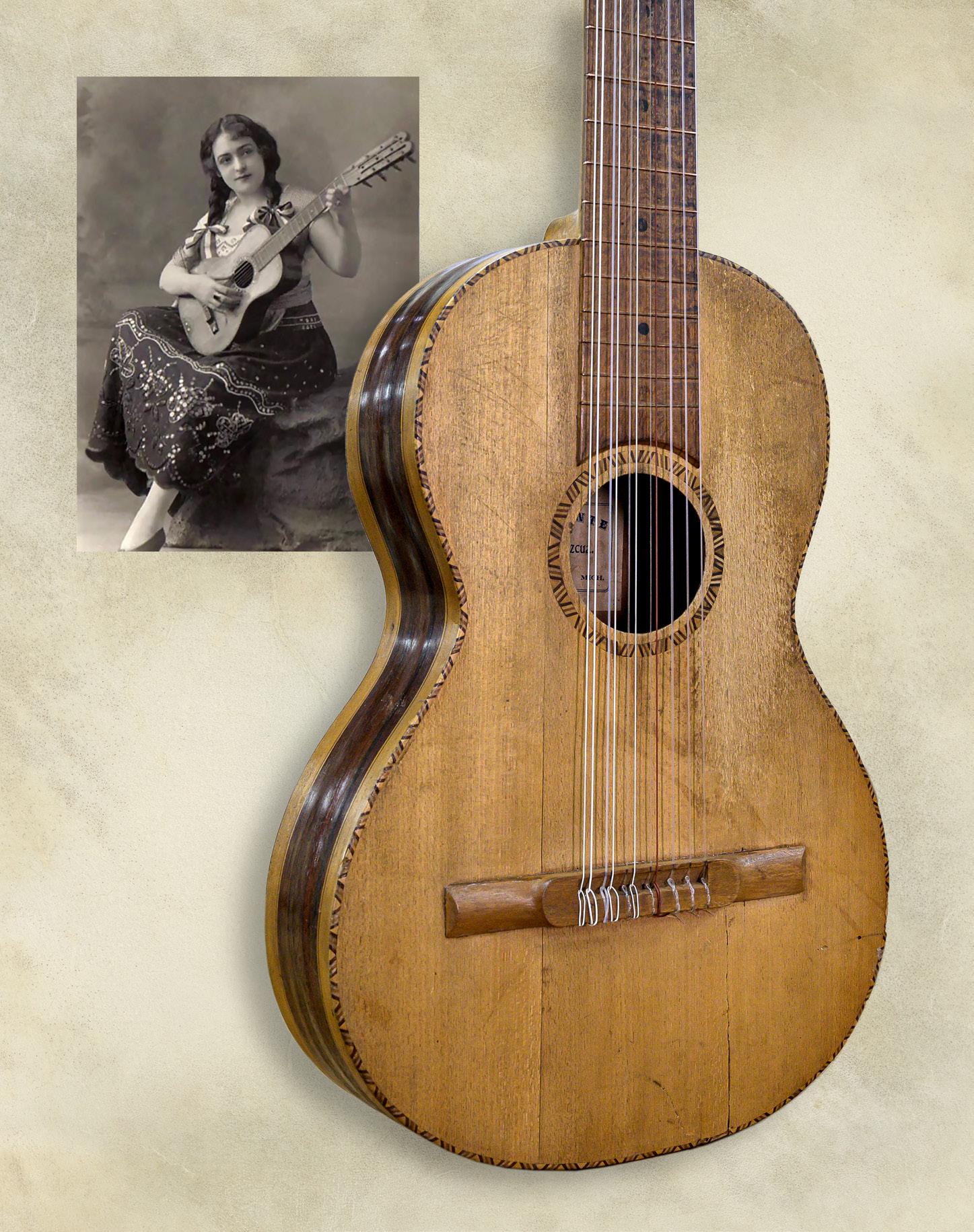
“Guitarra séptima” from Jorge Martín Valencia Rosas’ collection. Above, actress Mimi Derba.

Women bearing guitars and in traditional dress precede the procession of luthiers.

The forests in and around Paracho comprise mainly spruce and oak. But these days any and every kind of wood used for lutherie can be found in Paracho. Better communications and increased demand have spurred the rise of spe cialised wood trading firms, offering every imagi nable imported variety. Moreover, these firms en joy privileged access to typically Mexican woods, such as granadillo ( Platymiscium yucatanum ), paloescrito ( Dalbergia paloescrito ) or guayacán ( Guaiacum ), which is difficult to work with be cause the wood is so hard.
It is a typical feature of Paracho’s luthiers. Ow ing to the difficulties in obtaining quality tools, some of these knives are fashioned out of up cycled metal from other tools, such as chisels made from metal files, and knives from old metal saw blades. Each luthier makes their own and it is the go-to tool for crafting guitars. The skill that these luthiers have developed with such knives is astounding.
Each year in August, Paracho’s Festival Internac ional de la Guitarra is held. This is a week-long guitar fair encompassing myriad events: guitar concerts, lutherie competitions and parades of all descriptions.
As part of these annual festivities, there is also a national-level competition for luthiers, designed to promote improved construction techniques.
Over and above aesthetics, consideration is given to various other elements of the guitars: the power and balance of their sound, accuracy, richness of timbre and playing comfort. One curious aspect: two months before the event, the luthiers entering instruments in the competi tion must submit, in person, the as-yet-unassem bled wooden components (soundboard, back and ribs) so that they can be stamped by the or ganising committee.
The contest has several categories: popular gui tars, student guitars, con cert guitars and Grand Maestro guitars. The fin ished guitars are to be submitted anonymously, with neither the signature nor label of its creator. The winner of a given category must move up to the next category the following year.
If you were to head along Paracho’s main street you would come across, tucked in among numer ous guitar stores, the shop belonging to luthier Jesús
A luthier’s hand-knife is often made with upcycled metal.

Zalapa. Inside you will find all kinds of stringed instruments, pictures illustrating how a guitar is built and even a workshop featuring all of the usual tools… but in miniature!
Jesús, like most of Paracho’s artisans, learned his craft from his father, but what most caught his fancy was the concept of creating miniature instruments.
He showed us five guitars that could fit in the palm of his hand and a fully equipped luthier’s workshop built inside a normal-sized classical guitar, complete with work bench, tools (knife, saw, plane, sandpaper…) and some half-made guitars. Some museums have re cently taken an interest in his work and purchased several of his tiny master pieces.
The Walt Disney Studios 2017 film, “Coco”, tells
The exhibition featured a guitar measuring 2.6 m.

The guitar by Fructuoso Zalapa that won the “Grand Maestro” category.

Tonewood in stock at Materiales Mendoza, run by Rosa Elena.
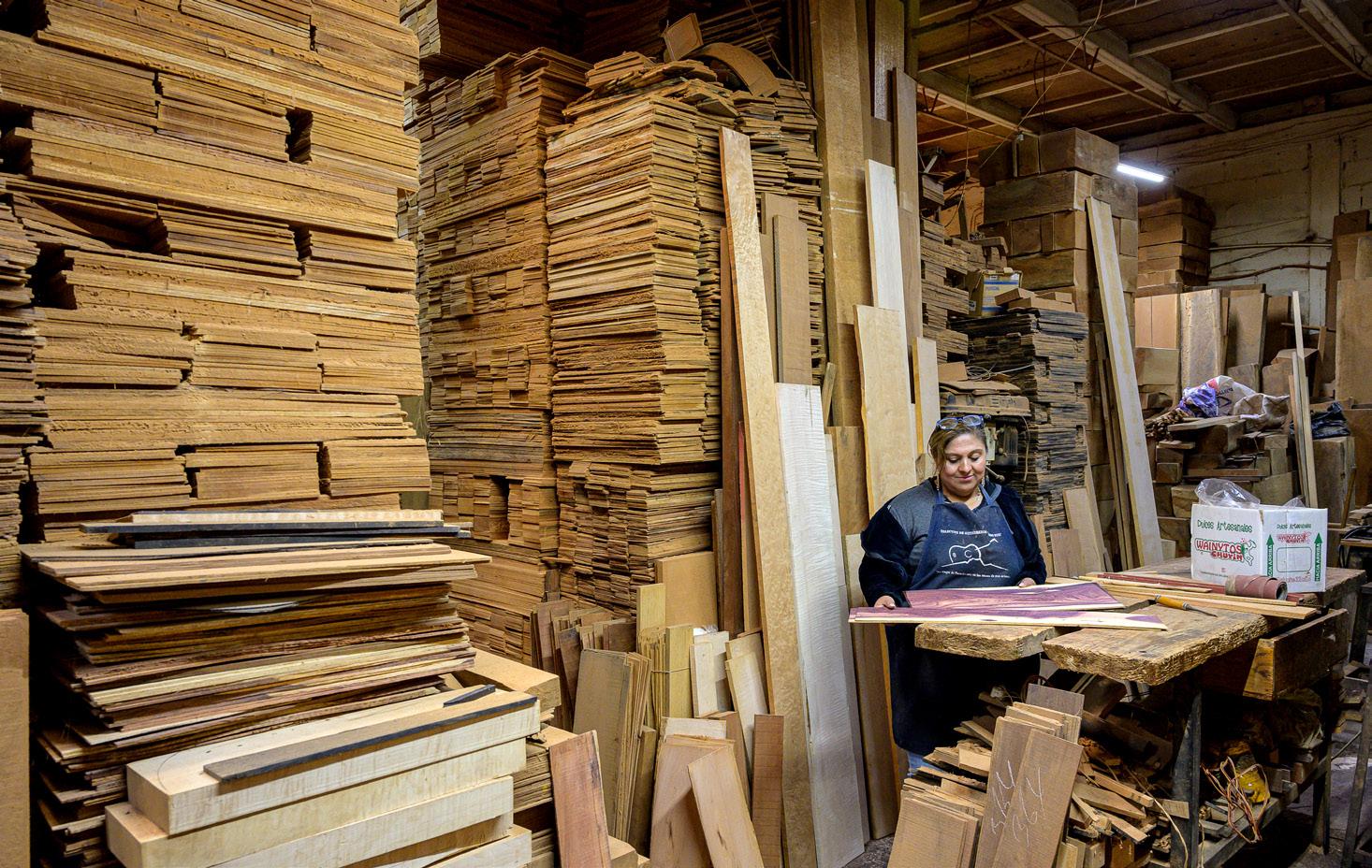
Jesús Zalapa and his miniature guitars (see also the cover of Orfeo).
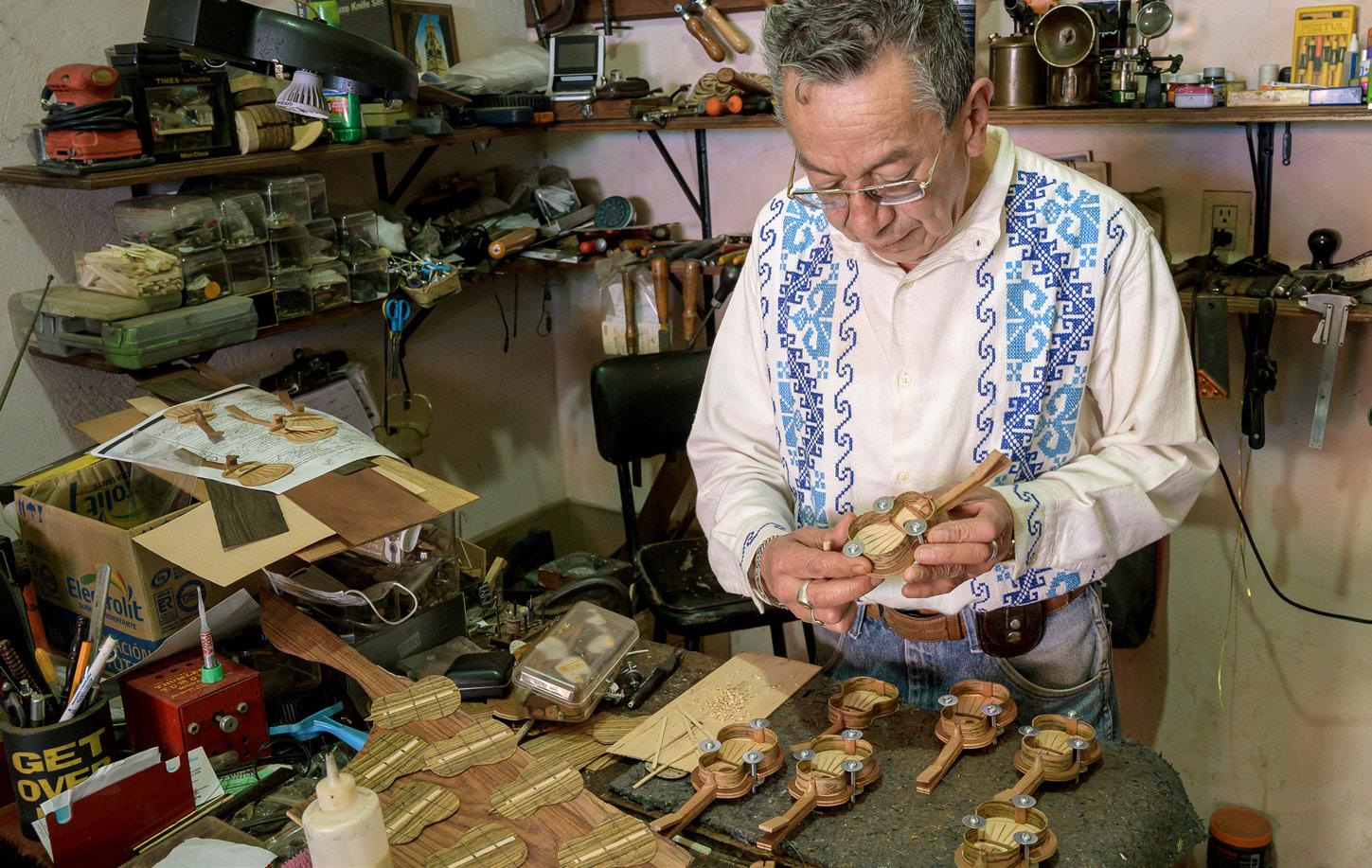
the story of a Mexican boy called Miguel, who dreams of becoming a musician and owning a guitar like the one played by his idol. The creation of the “Coco” guitar was entrusted to Germán Vázquez Rubio, a master luthier born in Paracho and living in Los Angeles. The original guitar’s ornamentation features mother-of-pearl and inlaid gold.
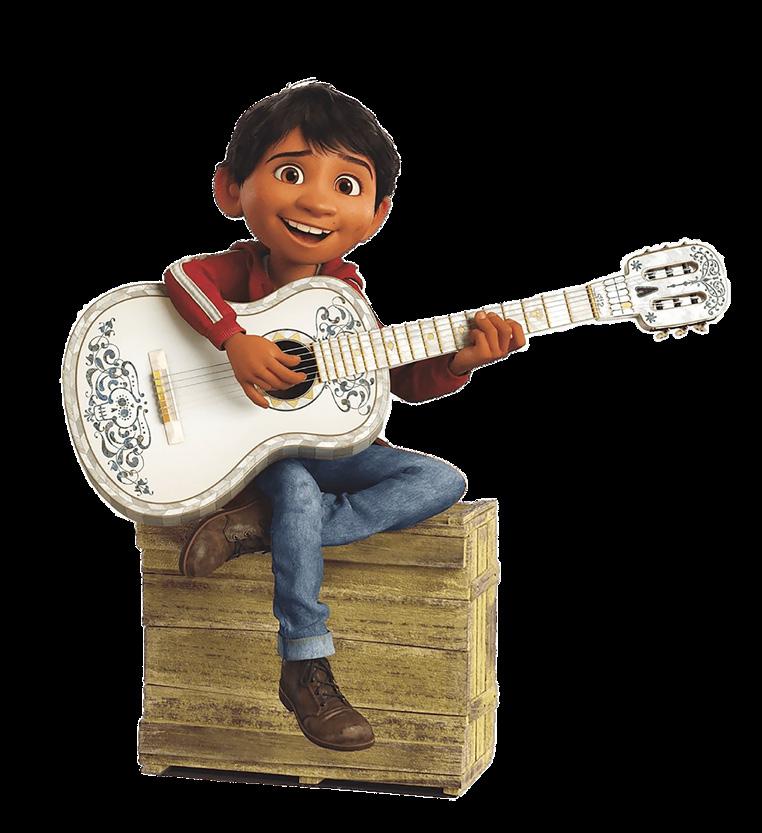


The movie’s success was a boon for Paracho. Suddenly imitations of the “Coco” guitar, with price-tags for every budget, were being churned out like there was no tomorrow. For several years, it was the city’s absolute best-seller!
Below left, Miguel and his “Coco” guitar. Here, a copy of the guitar.
The success of the film “Coco” was a game-changer for Paracho.
Abel García is the most international of Paracho’s luthiers. His search for perfection led him to work with the Romeros in California, with José Luis Romanillos in Spain and with top contemporary luthiers.

How did you learn your craft?
Abel García – I learned with my father. He had rather a rustic workshop, like so many of the workshops in Paracho at the time. I was the ninth child in the family. Times were hard: my father would work in Los Angeles for several months of the year and come back here with wood and tools to sell locally. My father would build the guitars during his stints at home and my mother would do the finishing and varnishing.
And when did you start making guitars?
A. G. – At the age of nine, I built my first guitar with the hope of selling it in order to help my family.

By then, my father had a better workshop, with a few employees and a small shop on the main street in Paracho, and I liked hanging out in his workshop. When I was about 13 years old, I told my father that I wanted to be a luthier, but he asked me to first go to university. So I went off to Morelia and studied chemical engineering, mechanical engineering and computing. At the same time, I took classical guitar lessons and I continued making and repairing guitars whenever I had time. One day, an American lady came along looking for an acoustic bass guitar; I agreed to make it and she asked me to bring it to Los Angeles once it was ready. There, I was able to visit José Oribe’s studio; a professional workshop beautifully equipped. But what really changed my life forever was my encounter with Celedonio Romero. He was such a kind host, and he invited me to view

and listen to his guitar collection. Hauser, Santos, Miguel Rodríguez… I had never seen or heard anything like it! All of this really helped me to progress in my own work and also turned out to be a considerable financial boost, because all of the Romeros ordered guitars from me for their pupils. In the end they suggested that I set up a workshop in Pepe’s garage!
And out of all of those guitars, which ones made the greatest impression on you?

A. G. – My favourites were the 1975 Hauser II and the Miguel Rodríguez from 1973 called “La Wonderful”, but the Santos and Torres guitars also influenced me a great deal. My guitars got
Right, his personal bracing, an interesting blend of influences.
Rosettes with pre-Columbian motifs.
Copy of the Torres FE 17, crafted by his wife, Verónica Ayala, in 2017.


better and better and in 1992, Pepe told me that Romanillos would be running a course in Córdoba and sent him a letter asking him to take me on. It was upon my arrival in Spain that I discovered that Romanillos expected everyone to bring their own tool-kit and the wood needed for making a guitar. I had travelled empty-handed and since I didn’t have the money to go out and buy the required wherewithal, I decided just to work with the bare minimum, like the Paracho luthiers do. Romanillos and the other participants were surprised to see me turn up with nothing but a knife, saw, plane, twine and some wood that Ignacio Rozas had spared me in Madrid. That particular year was the centenary of Torres’ death, and the guitar that we were tasked with copying was “La Suprema”, using a plan that Romanillos had made. I was the only one to actually finish the guitar before the course ended; I even had time to varnish it!
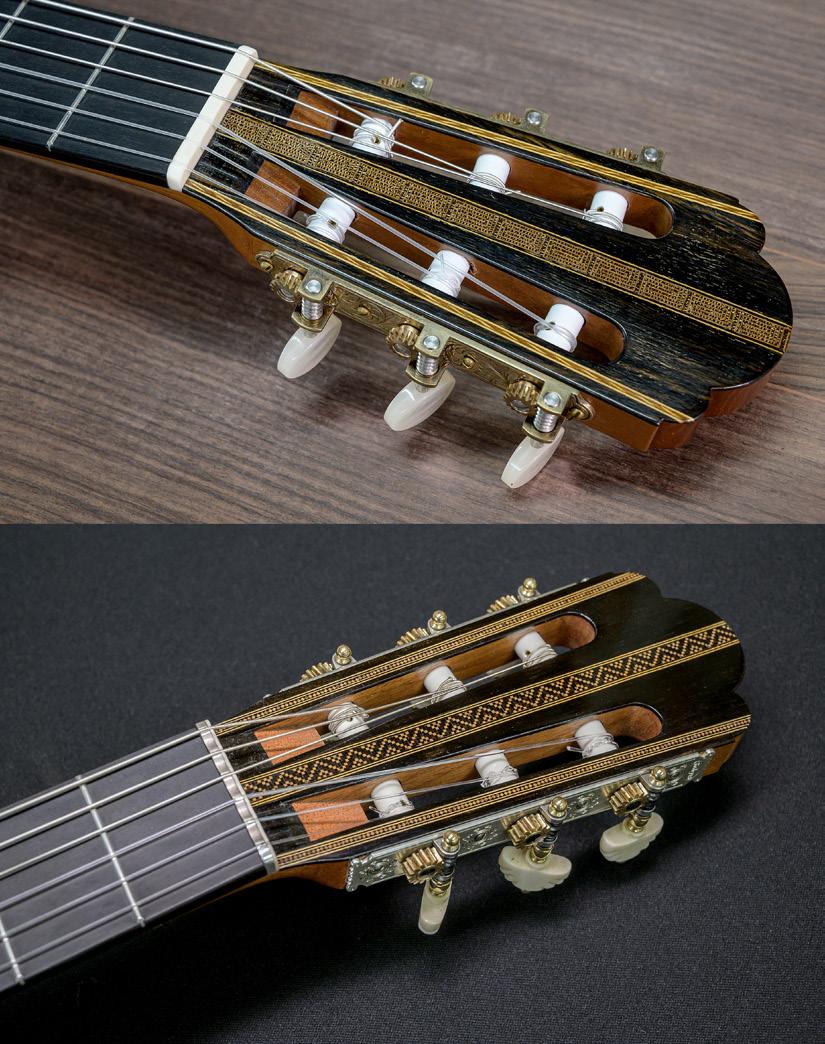
 Headstock of the FE 17 replica made by Verónica Ayala.
Abel’s personal model, with red cedar soundboard.
Headstock of the FE 17 replica made by Verónica Ayala.
Abel’s personal model, with red cedar soundboard.
Later on, I returned to Spain for the 1993 course, and in 1994, Romanillos invited me to join him as an assistant. His courses were marvellous; I have never seen the like anywhere else. For me, it was fantastic, opening the door to the world, and I think that it may have helped put Paracho a little more firmly on the map. That’s where I was really able to network and the orders started rolling in.
For the replica of “La Cumbre”, did you have plans from which to work?
A. G. – There are no plans for “La Cumbre”; there was no way to study the original guitar itself. I took my cues from all of the Torres guitars that I had come across as well as the available bibliography. Despite never having seen the original, I think that my replica is quite a faithful reproduction. I started the drawings in 2006, bought wood matching Torres’ wood as closely as possible, and I finished
the guitar in 2015. It was a most challenging project, requiring great precision, because if I failed to respect the exact thicknesses for the strips of purfling wood, then all of the meanders, ear of wheat patterns and the other adornments would end up being wider than those of the original. I had to analyse numerous photos and perform a lot of calculations to determine the exact size of each piece and each strip.
My wife, Verónica Ayala, who is also a luthier like me, made a replica of the Torres FE 17 which also sported meanders.
Aside from Torres copies, do you also have your own model?
A. G. – Yes, as of the 1990s, I started making my own personal model, inspired by all of the superb guitars that I had encountered. I have even added Robert Bouchet’s bar to my bracing,
 Verónica and Abel with their store of tonewood.
Verónica and Abel with their store of tonewood.
Nine years of research, deliberation and work to complete the replica of “La Cumbre”.


“I never got to see the original, but I think mine is quite a faithful reproduction.”
albeit utilizing different thick nesses and arranging the fan’s outermost braces underneath that Bouchet bar. Everything changes over time, though, as we develop, always seeking an even better sound.
A. G. – I build about six or seven guitars per year and my model is quite close to that of the Hauser II of the Romero family. I build in the Spanish style, starting with the soundboard and neck and with an angled neck-head joint. For a few years now I have been trying to make rosettes with pre-Columbian graphical elements. They are wonderful, but I avoid overly vibrant colours and aim to make them elegant and refined. For the back and sides, in Mexican woods, my favourite varieties are zopilote and paloescrito. There are about a dozen different kinds of hard woods to be found here (paloescrito, campincerán, zopilote, etc.), as well as several
Many guitarmakers trained by Abel have become high-level luthiers. Here, a guitar made of ovangkol (Guibourtia ehie) by Gerardo Escobedo.

types of spruces (Picea abies), because we are at an altitude of 2,200 metres. But for my tops, I prefer the sound of European spruce.
A. G. – Paracho could conquer the world with its guitar manufacture. We have both fine woods and extremely capable luthiers. On the lutherie courses that I have taught, I have come across some extraordinary pupils, but in Mexico things just aren’t conducive to them achieving the success that they so clearly deserve.

It is difficult for them to sell their guitars in other countries. To resolve this, fairs need to be held abroad, and the visibility of Paracho-made instruments needs to be raised.
If we are truly to develop, what is really needed is top-down government support, a museum/ documentation centre and a school of lutherie!
The breath-taking marquetry on the “La Cumbre” replica.
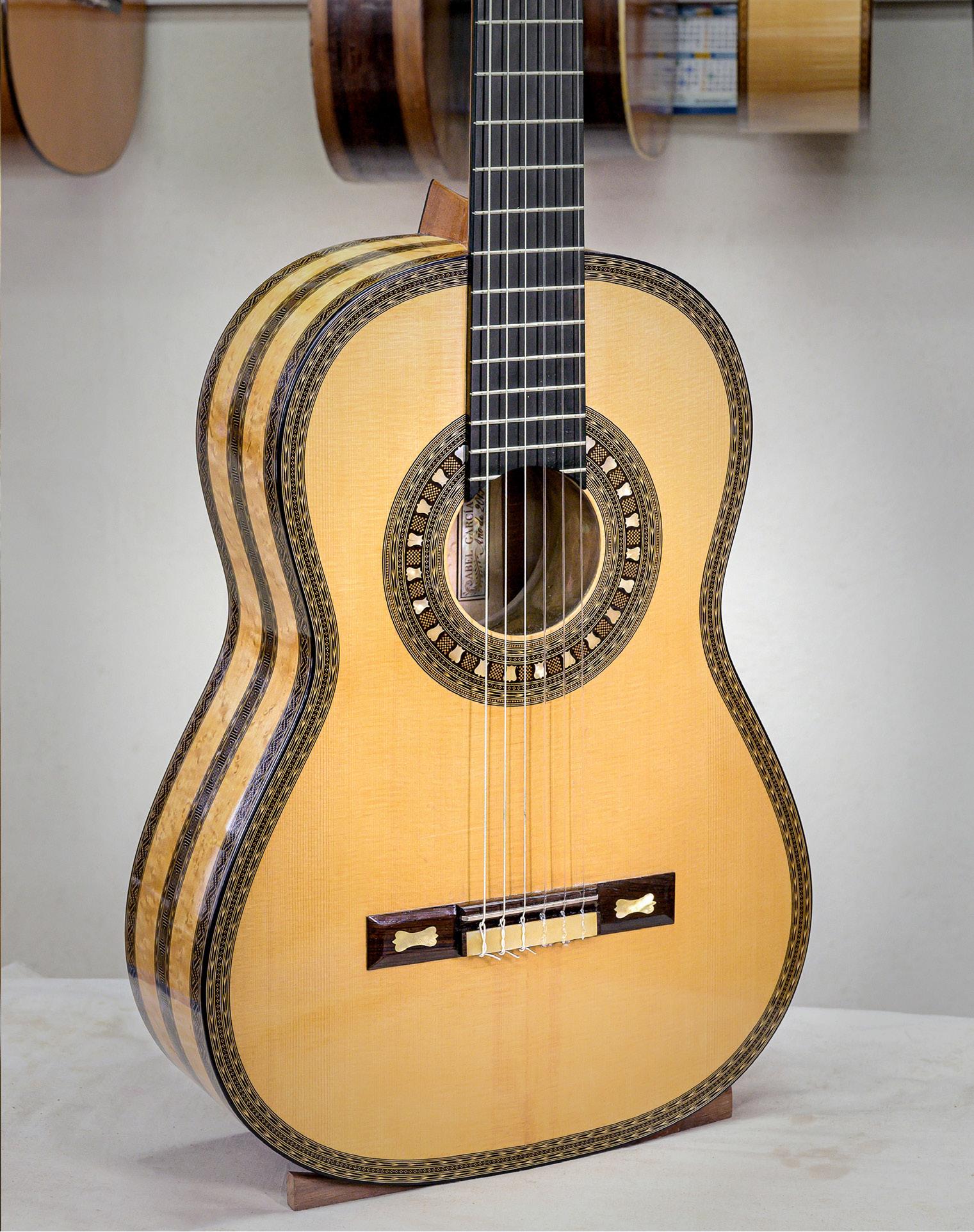
Summertime in Paracho is also the rainy season, with heavy afternoon downpours!
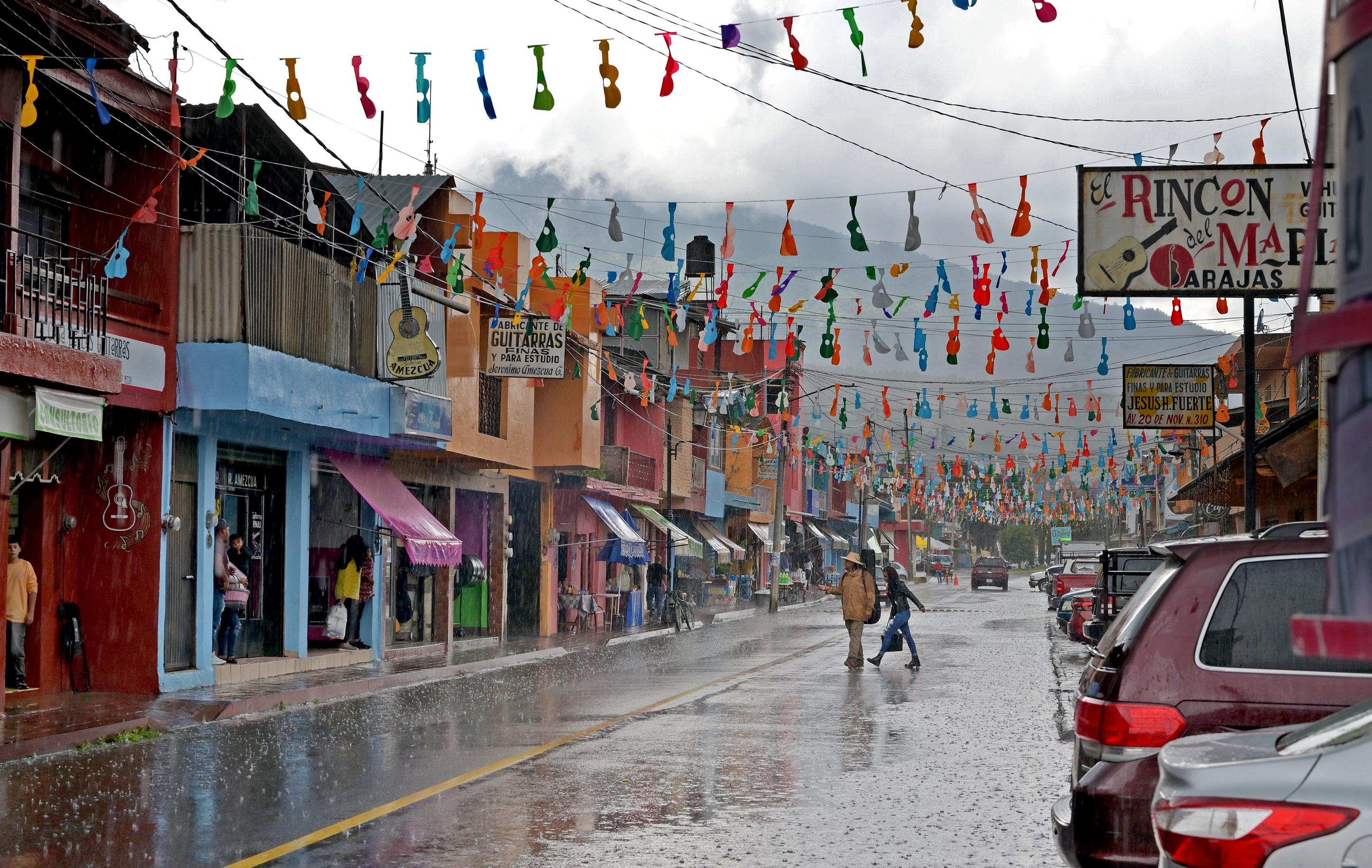

Born in Paracho, but living in Morelia, the State capital of Michoacán, he splits his time between California and his Mexican workshop. This year, he was awarded the top prize in the Grand Maestro category of the guitar-making contest.

Did you learn lutherie from your father?
Fructuoso Zalapa – Yes, I learned with my father. Mine is the fourth generation of guitar luthiers in the family, but I also took several of Romanil los’ courses and I am close friends with Manuel Cáceres, an excellent luthier from Madrid. When I next travel to Madrid, I hope to convince Manuel to build a double-top guitar. Double-tops offer boundless potential. Whenever I make a Torres, Hauser or Romanillos model, it always turns out to be the very guitar that I had in mind. With a double-top, you can make a hundred guitars and each and every one of them will be different. I find this incredibly motivating and it has taught me a great deal. Being able to use such gossamer-thin and delicate slices of wood has refined my work;

Construction of the all-wood lattice bracing.
it has given me the confidence to shift toward tra ditional, fine-gauge soundboards, like those of the Spanish masters.
You mention double-tops, but here we see your soundboards are lattice-tops; they are two different things!
F. Z. – Yes, I use both: double-top and lattice, because the double-top works better with lattice bracing. It doesn’t work with conventional brac ing: it needs the lattice, and preferably all in solid wood; carbon is a different kettle of fish.
I like guitars with double-tops with Nomex sand wiched in the middle. I have also tried with a bal sa core, but the result was not as good. I always combine a spruce layer and a cedar one. In this
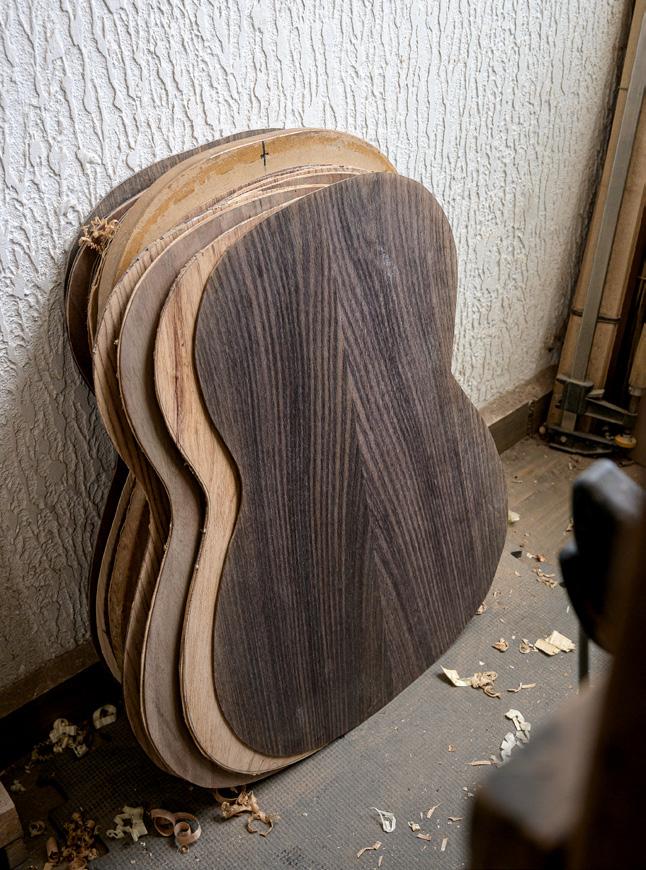

way, I finish the soundboard on either one side or the other, depending on whether the order was for spruce or for cedar. This is not only for aes thetic reasons: it also subtly modifies the sound. You would think that it would sound the same, but something somehow changes and the result ant sound is different. When the outer face is of spruce, the sound is slightly finer and clearer, with more harmonics. Unbelievable though it may seem.
Another difference that I have noticed is that a double-top needs more time than a traditional top to free itself up. After two or three years of age, my double-top guitars improve a lot. For ex ample, a Romanillos model, two years after con struction, will have gained 10%, while a doubletop will have gained 30%. Very often a double-top guitar will come back to me after two or three years because its varnish needs a touch-up or
perhaps the saddle or nut needs adjusting, and I see that the guitar has matured for the better. Don’t ask me why…
Was the guitar with which you won this year’s competition like that?
F. Z. – No, it was not a double-top; the sound board is of solid cedar because the contest rules require that the guitar be of recent construction, and I opted for cedar which is offers more gener osity quickly.
F. Z. – When I am making a flat back, I add struts for reinforcement, but if I am making a domed back, I don’t add anything; the arch itself suffices. I make the curved backs using three laminated layers: for example, with paloescrito, white cedar
 Bonding the lattice bracing to a double-top of spruce and red cedar.
Bonding the lattice bracing to a double-top of spruce and red cedar.
His formula: stiff body and light membrane.


“The sideports help guitarists hear what they are playing.”
 A Romanillos model with spruce top and body of paloescrito.
A Romanillos model with spruce top and body of paloescrito.
(Mexican cypress) and kingwood. The sides are also laminated, which I find enhances the basses and is more reassuring because kingwood and cocobolo are prone to splitting. The problem is that domed guitars take a lot more work, and so are more costly and thus more dif ficult to sell. But I do prefer them. I always ensure that the body is quite thick: 2.5 to 3 mm. That feels like the right way to do it: a stiff body and a supple membrane. I always use solid linings; I feel that if the lin ings are made with peones , a little sound gets lost, since the gluing needs to be as uniform as possible.
F. Z. – In Paracho, the summers are tremendous ly humid. Even here in Morelia, where I now live, I need the dehumidifier on all the time. Paracho has very dry winters and very humid summers. That is why I came to live here: the cli mate is somewhat better. In my workshop, I try to keep the humidity at around 50%. That is also the
reason why I use modern glue. Hot glue is too sensitive to temperature and humidity.
F. Z. – My favourite of all is Brazilian rosewood. It is a wood which, when of top quality, gives back the sound in its entirety, without absorbing any of it. Both cocobolo and kingwood are similar, but I do think that Brazilian rosewood is superior. Wood has its own magic, too. I can build several guitars using the same wood, but they will not all offer the same result. I always use Honduras ce dar for the neck; Spanish cedar is very good but difficult to find here.


F. Z. – The idea behind making a two-part saddle is to optimise contact with the bridge and make it possible to adjust the string height for basses and trebles independently. The sideports help guitarists to hear their own playing. I also like making Romantic-inspired gui tars. They are not copies of any particular guitar;
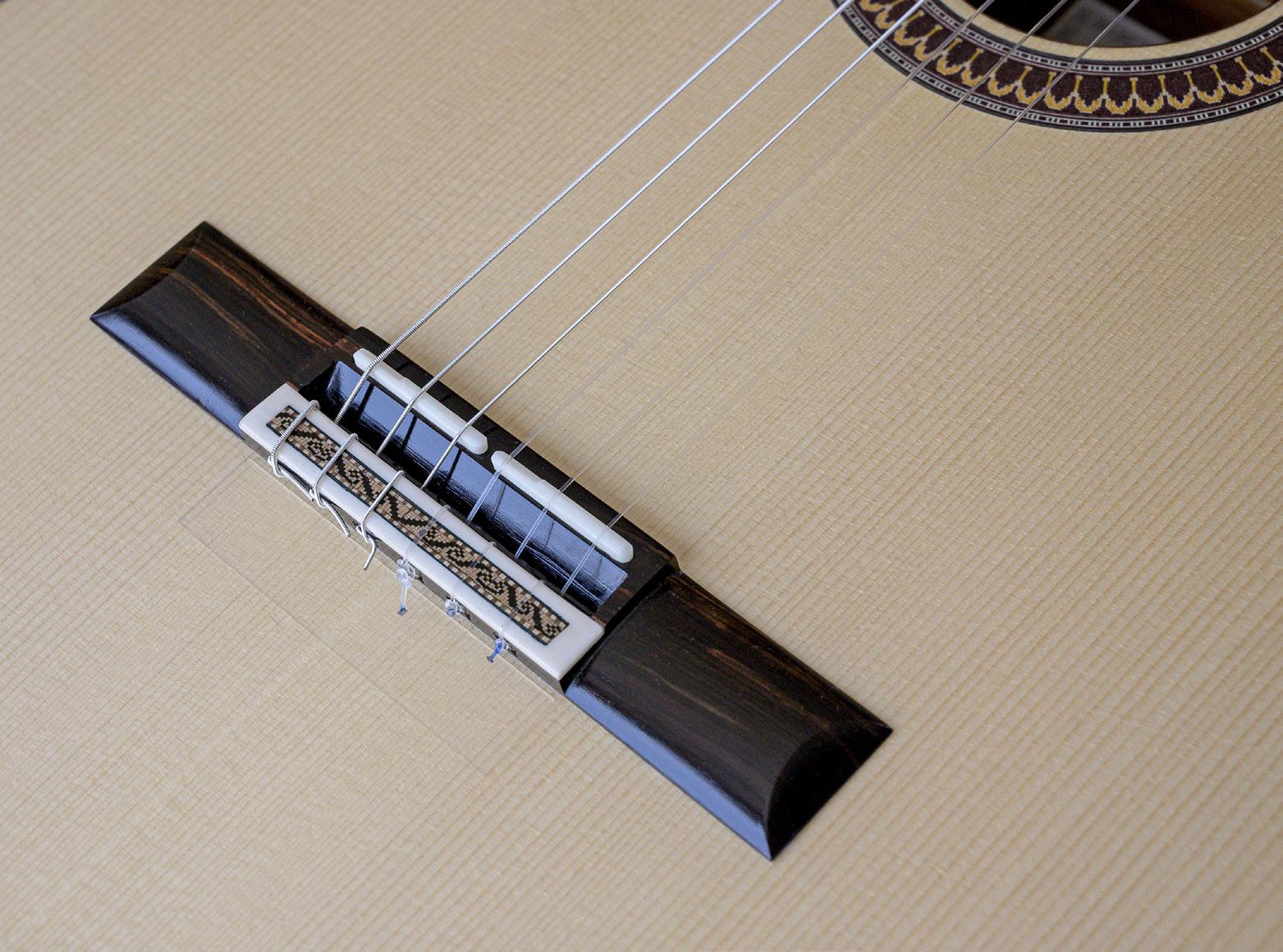 A two-part saddle for optimising string height.
A two-part saddle for optimising string height.
rather, they are guitars made in that style. On the last one that I made, I added a twelve-hole bridge and an armrest to make it more comfortable. My Romantic guitars are more like modern interpre tations of the Romantic guitar.
And which guitars have left the greatest impression on you?
F. Z. – One of my favourites, out of all of the gui tars that I’ve encountered, is a Daniel Friederich that belonged to Mexican maestro, Enrique Ve lazco. Although I like the sound of double-tops, like Dammann or Wagner guitars, I have to admit that the Friederich blew me away.
I also work in the United States at Kenny Hill’s, between four and six months of the year, and I enjoy going there. Kenny is a great person and I work in very good conditions.
It is over there that I make the high-end guitars, the “Signature” models. Whenever I return, I make the most of the trip to bring back tools and wood, especially soundboards, because the wood for soundboards in Paracho isn’t good.

We luthiers work 365 days a year. I am currently finishing guitar number 972 with my signature and I still believe that ours is one of the most beautiful professions there is.

“I like making Romantic-inspired guitars. They are not copies; rather, they are guitars made in that style.”
Superb marquetry workmanship.
The tuning machines (left page) and armrest are modern touches that Fructuoso adds to his Romantic guitars.

Wall painting, as is traditional in Mexico, in the streets of Uruapan, 35 km from Paracho.


Daniel is the oldest of Paracho’s luthiers. At 82 years of age, and with more than three thousand guitars under his belt, he is still producing a guitar per month.

Daniel Caro – After primary school, in the 1950s, I told my mother that I didn’t want to study, that I wanted to work. She asked a neighbour who was a guitar luthier if he could show me the ropes. Ini tially, I would watch how the others worked and little by little, I started learning how to make gui tars and, above all, how to spot the mistakes that I was making. Then I began to correct them, and to make progress.
After two years, my father bought me some tools so that I could start working solo. At first, I worked in the usual local way (see boxed text: Mexican Maquila): I would be given the wood; I would build the guitar but I would submit it unfinished, with no frets, no tuners and no varnish. Some time later, I started to sell my finished gui tars to several stores, strings installed and ready to play. I worked a lot; there was one week in which I managed to build six guitars. I would do


everything like on an assembly line: make six necks, six soundboards, etc. I made the most of the dry weather because I didn’t give them a long time to dry. In the end the burning sensation in my hands was such that I had to slow down to a rate of three or four per week. I would sell these guitars in Mexico City, in Guadalajara, in Monterrey… even in Laredo (Texas), since I had obtained that passport that enabled people living near the border to go in and out of the United States easily.
D. C. – Yes, I made good use of that passport and went to Los Angeles to look for work and I was hired by a workshop that made and re paired guitars. That is how I came to see and to study the guitars of the great master luthiers. It was there that I was lucky enough to see guitars by Hauser, Esteso, Santos Hernández and Tor res. I was particularly struck by Fleta’s guitars be cause of the quality of their manufacture: almost feeling the presence of this great craftsman. One day, a guitarist stopped by and asked if he could
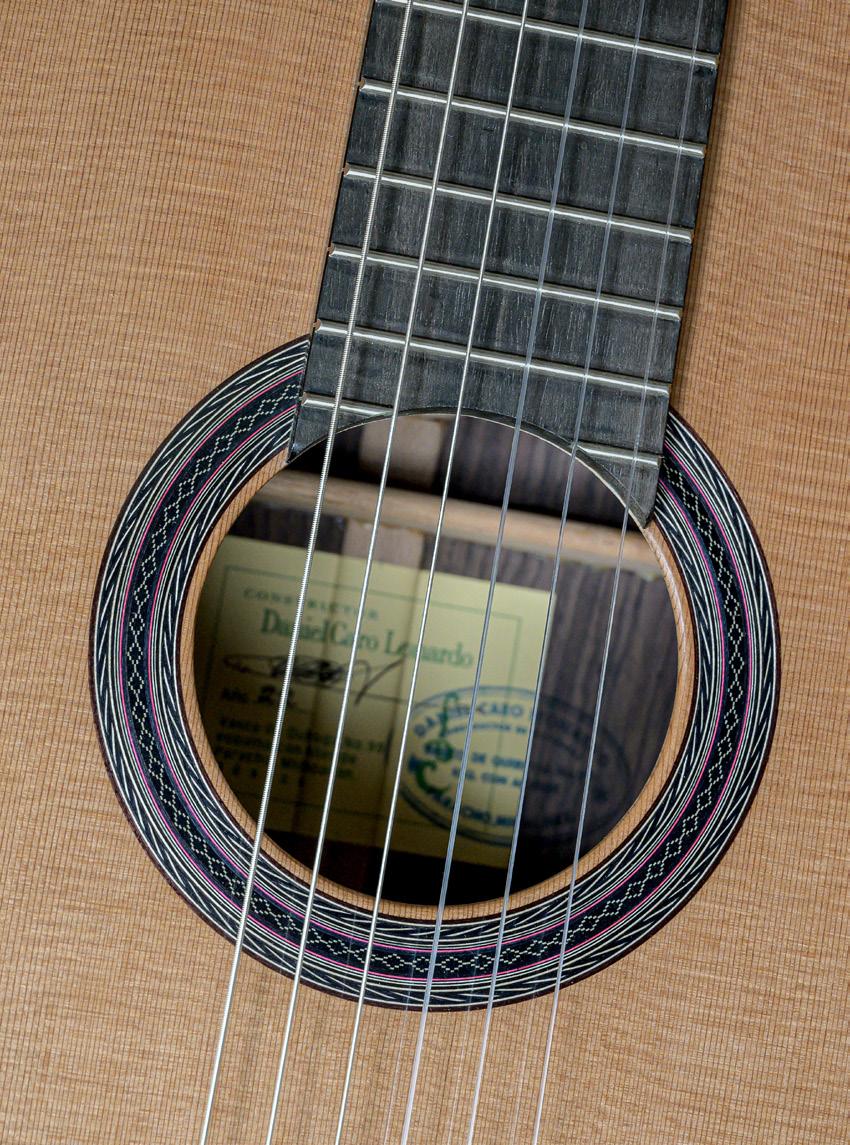

A tool of his own invention for assembling guitars.
The luthier’s knife: an all-purpose tool.



“The industry churns out hundreds of guitars a day. Worlds apart from what we do: our work is art.”
Red cedar soundboard and Indian rosewood body. Unvarnished bridge, as is typical in Paracho.

During the Second World War, the Programa Bracero (Mexican Farm Labour Programme) was established to overcome a shortage of manual labour due to the war effort. Under this scheme, which ran from 1942 to 1964, Mexican seasonal labourers could work temporarily in the United States. Some four million workers from Mexico crossed the border to work.

In 1964, when the programme came to an end and the returning labourers needed employment back in Mexico, the notion of facilitating the creation of border-area industries came to the fore. A maquiladora is a firm that imports raw materials tax-free, performs the processing or manufacturing in Mexico, and then exports the finished products, also tax-free, provided that the assembly and sale remain the sole preserve of the country of origin supplying said raw materials.

The word “maquila” has its roots in mediaeval Spain, where it once described a system whereby a miller would agree to mill a person’s grain, in exchange for a portion of the resultant flour as payment. In the case of the guitar-makers in Paracho, it refers to performing part – but not all – of the instrument’s manufacture for a company.
Nothing in the street indicates Daniel Caro’s studio.
play the Fleta that I had just repaired. He played it and said to me: remember this sound; the day that you reach this level, you will be a good luthier.
Do you build following the Spanish method, starting with the soundboard and neck?
D. C. – Yes, albeit in a slightly different fashion. I have my own way of working and I created a tool that guides me for constructing the guitar.
D. C. – I feel the wood of the soundboard with my hands and I make the bracing accordingly. Gen erally, I use a fan shape with seven open braces, but sometimes I close the fan at the bottom with two struts in a V formation. Everything depends on what the wood tells me. Lastly, once the guitar is completed, I tap the soundboard so as to fine tune it by sanding on the underside. That is the most important step of all.
D. C. – Around here, the bridge is usually left un varnished; we leave it plain, like the fingerboard. That’s the Paracho style. The heads on my guitars have a shape inspired by Fleta. As an added safeguard, the neck is re inforced with a piece of granadillo; about 8 mm thick and 30 mm wide. From the outset, I wanted to do things properly, even on inexpensive gui tars. Whenever something failed to come out right, I would get annoyed with myself. That really pushed me to keep improving, doing a little bet ter every day… and still today, at 82, I craft my guitars with that same stringency!
Some features on his guitars are inspired by Fleta.



Carlos has been giving classes in lutherie for fourteen years and has even produced a manual on guitar construction. His advice to students: do it with love!

Tell us how you got started.
Carlos Piña – I learned lutherie in Mexico City, our capital, in the 1950s. In those days, the gui tars coming out of Paracho were a bit rough, fac tory-made. In Mexico City, I apprenticed in vari ous workshops for about eight years. After that, I worked for the factories as a “maquila” worker (see boxed text on previous page), which boiled down to being an employee but working from home. I would hand in my guitars with all of the wooden parts completed, with separate bridge, but without frets, head, varnish or strings.
At the age of 23, I got married and came to live in Paracho. I kept working for a “maquila” but I was submitting finished guitars, ready for sale. Around here, there were women who did the varnishing and people specialised in creating rosettes and purfling. Sometimes I would do the varnishing or rosettes myself, but it was easier to leave it to the specialists.
C. P. – Now I work as an independent luthier. I have also been teaching guitar-making for fourteen years. It is a three-year course in which I teach all the basics of guitar lutherie. I have

“It is very difficult to offer only one’s personal model.”
published a manual on artisanal guitar construc tion, written with Mario Fuentes. This gives me less time to actually build my guitars in the work shop. Today, I produce about four or five guitars a year.
In my teaching, I show how all of the models are made: Torres, Fleta, Miguel Rodríguez, San tos Hernández, Simplicio and also Gerundino Fernández, as an example of flamenco guitarmaking; all the great guitar luthiers from that wonderfully creative Spanish period.

I teach my pupils the conventional Spanish con struction method, but also how to build with the neck and the body separate.
It takes time for a luthier to mature professionally, generally around thirty or forty years of age. It’s a profession that calls for constant development: the guitar that I build today is not the same as the one that I was building ten years ago.


C. P. – I like to make the tops out of German spruce or Canadian cedar, which explains why I don’t use Mexican wood. For flamenco guitars, however, I use white cedar or Mexican cypress ( Cupressus lusitanica ). For my classicals, I enjoy working with Indian rosewood or Mexican paloe scrito. Our wood is exceedingly beautiful, and comes in every colour and pattern; it offers just as many variations as Indian rosewood but is a little less dense.
To give the body greater strength, I sometimes used laminated, or lined, backs. This also helps
Travel guitar and classical guitar, as yet unfinished.


A small guitar with a pared-down fourstrut bracing.
Paracho has always had its rosette specialists.
enhance the sound. If I use Indian rosewood on the outside and cypress on the inside, for exam ple, the timbre changes; the sound is better de fined, more balanced, with brighter trebles and basses that sing out more strongly. Not only is it better than using rosewood alone; the guitar will be all the more robust, too. The decision to line the backs, or the sides, or both, depends on the client’s requirements. It is very dif ficult to offer only one’s personal model. In this regard, the custom er is definitely aways right and so the luthier needs to tailor the con struction to fit the order. A friend of mine once asked me to build him a compact travel guitar, with a 61 cm neck and as small a body as possible. I had never made such an instrument before,
but the request was from a friend and I can’t just say no to a friend! So I made it.
C. P. – Yes, I have my own model, made with my solera . What can vary a bit depending on the or der is the wood and the bracing: traditional fan, lattice, etc. For fla menco guitars, I use fan bracing with triangular struts; they are the ones that give me the most spon taneous sound, the most rapid re sponse. My classical guitars have lower-profile braces, so that the soundboard is freer and the notes have greater sustain. For the small
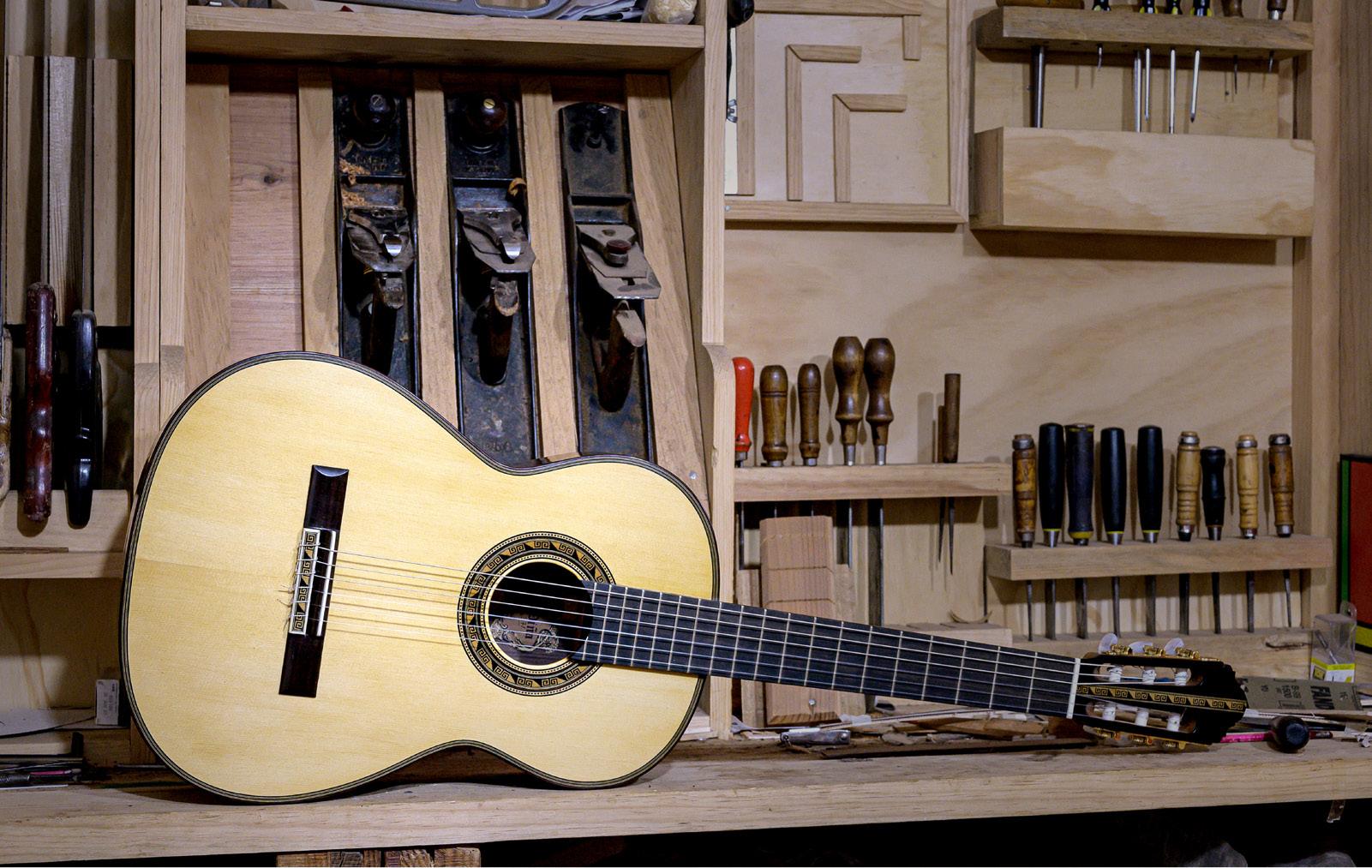
 For this guitar, his ornamentation uses pre-Columbian designs…
For this guitar, his ornamentation uses pre-Columbian designs…
guitar that I have in the workshop, I came up with two slanted braces and only four struts: two on the treble side, one on the bass side and one in the centre.
Which other guitar-makers have given classes here in Paracho?


C. P. – Our colleague, Abel García, invited José Luis Romanillos to come to Paracho and I attend ed his course and built a guitar with him. Antonio Raya Pardo and Thomas Humphrey also came, and gave two-week courses. The richness of the guitar lies in its diversity. Not all guitarists have the same taste or the same ear, and luthiers each have their own timbre, their own sonic signature. It’s a bit like the human voice: each is unique. Feelings are very important. It is essential to do things well and with love. When I set foot in my workshop, I leave my problems outside. There are no secrets in the guitar; the secret is in your heart.
 … with meanders for the back seam and the rosette’s central mosaic.
… with meanders for the back seam and the rosette’s central mosaic.
David is 28 years old.
He plays the classical guitar and has a scientific approach to lutherie. A rising star in the Paracho sky.
Which generation of the Rubio family are you?
David Rubio – I am the son of Arnulfo Rubio Orozco and I’m part of the fourth generation of gui tar-makers in the Rubio family. Germán Vázquez Rubio, the luthier who lives in Los Angeles and who made the “Coco” guitar, is one of my uncles. When I was a boy, I wanted to build guitars. It was only natural for me: my father was a luthier and my mother would varnish his guitars. I was eight years old when I started learning guitar at the Paracho school of music.
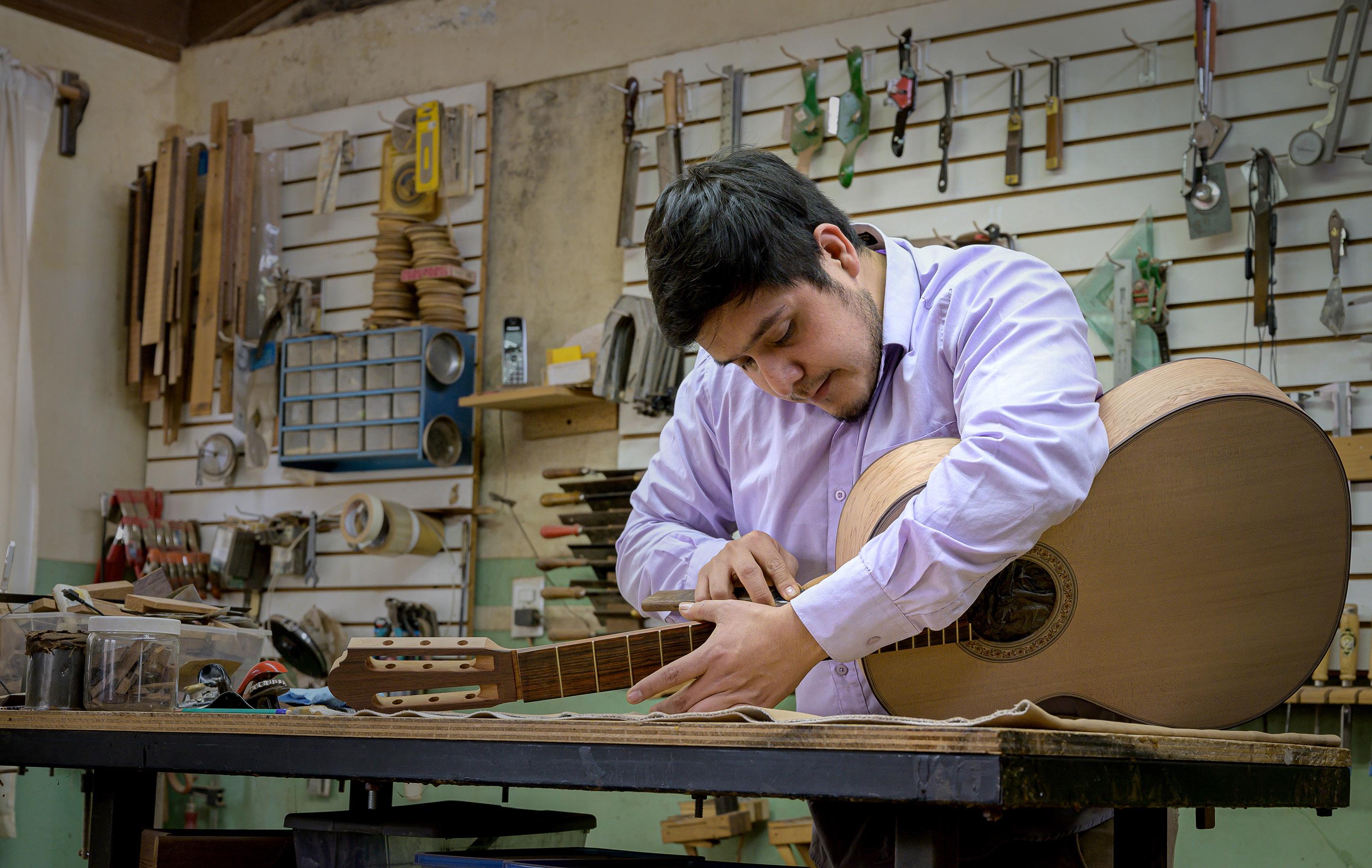
By the age of 12, I was already working in my fa ther’s workshop and at 18, I was making guitars from start to finish. I entered the lutherie contest for the first time and was awarded one of the prizes.
In your studies, what was your specialisation?
D. R. I studied industrial engineering and my

Paloescrito is a wood that displays diverse patterns and colours.
thesis was about optimal design parameters for building classical guitars using the Taguchi meth odology. Taguchi was a Japanese engineer who worked in the automobile industry and who con stantly sought to optimise the manufacturing methods and design of each component. My aim was thus to evaluate the traditional model of gui tar construction and try to take it to the next level, to optimise it.
One of the findings was that you have to work very precisely for all of the parts to fit perfectly together, without hav ing to force anything into place for gluing. Another conclusion was that in order to achieve a good acous tic response, you need to build a stiff sound

box, which can properly reflect back the energy generated by the soundboard, which has to be as free to move as possible.
And have you studied different types of bracing?
D. R. – Yes, I studied the traditional fan, lattice, double-top bracing, etc. It is clear that there is a mismatch between perception and taste. Ac cording to my measurements using a sonometer, double-top or latticebraced guitars give greater projection, but in a narrow, unidirec David builds with a very sturdy neck block…

Backlighting reveals the soundboard’s lattice bracing.

tional way. Traditionally-built guitars project less, but the projection is much broader. Each method of construction has its pros and cons, so this is really where the tastes of each luthier and each guitarist come fully into play. I staged an experi ment: I arranged a comparative listening session involving several guitars, and I invited several guitarists, an orchestra conductor and musicians experienced in playing stringed instruments. Overall, the musicians’ opinions matched the sonometer measure ments, whereas the opinions of the guitar ists were less objec tive.
Do you build the Spanish way?
D. R. – Yes and no. For example, I don’t use
peones ; I prefer continuous kerfed linings. I feel that there is greater precision this way; the indi vidual blocks used as peones have a flat surface and so the idea of bonding them to a curved sur face doesn’t seem right to me. Another difference is that I close the body with the soundboard last, so that it can be as free as possible. I make vari ous rosettes, and it’s the one with pre-Columbian designs that I use the most, but I also have one that pays homage to Antonio Marín. The current trend is to focus on obtaining more power, forgetting all of the guitar’s other … and his side braces look like suspension bridges.

qualities. I, too, am seeking power, but not at the expense of colours or balance. I use a latticestyle bracing, but entirely of wood and with a cer tain asymmetry.
My guitars are quite heavy owing to the sound box thicknesses: the back is about 3 mm thick; the sides 2.5 mm and the soundboard around 1.8 mm, and up to 2 mm in the upper bout.



D. R. – For the back and sides, I love the Dalber gias . I work a lot with Mexican paloescrito. For the tops, I prefer European spruce. I know that my guitars are not the world’s great est. What’s important is for me to be satisfied with what I am doing. Making a guitar is more than just cutting wood, gluing and sanding; there is also a lot of emotion, a lot of feelings that go into the guitar being crafted in our hands. As if proof were necessary, one’s guitar cannot be copied. It’s something that I saw when working with my father: both of us were making the same guitar, using the same wood and the same tools… and ultimately, they always ended up being different.
D. R. – Rather than recordings, my references are the guitarists who have visited Paracho and who I have heard playing live, in person: I loved the sound of the Daniel Friederich played by Zoran Dukić, the Matthias Dammann with which David Russell came once, and, when it comes to timbre, a Robert Bouchet guitar that is here in Mexico. One of the problems we face in Mexico is that guitarists want the guitar to sound amazing from the moment it leaves the workshop. But that isn’t how things work: the guitar needs time to dry out, to stabilise, and the guitarist needs time to work out all of the instrument’s potential. This is com mon knowledge to musicians who play stringed instruments. It’s fair to say that they generally don’t go out and buy brand-new instruments. In stead, they are looking for instruments that have matured and stabilised, and that already have a playing history.
He makes several rosettes featuring preColumbian motifs. Paloescrito is less dense than other Dalbergia species. Headstock that pays homage to Daniel Friederich. This guitar’s rosette is a tribute to Antonio Marín.
This guitar’s rosette is a tribute to Antonio Marín.
Paris, October 2022
Website: www.orfeomagazine.fr Contact: orfeo@orfeomagazine.fr